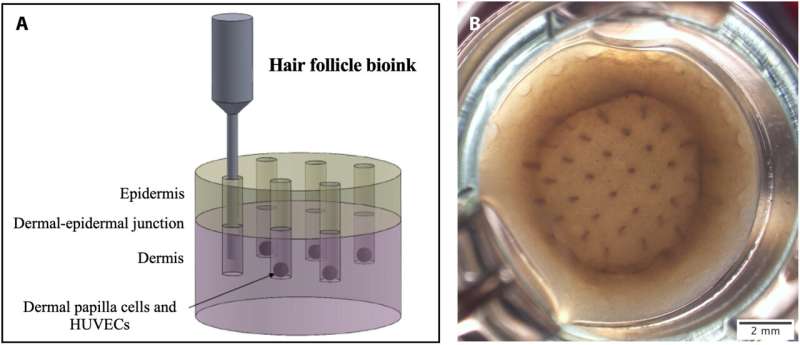This article has been reviewed according to Science X's editorial process and policies. Editors have highlighted the following attributes while ensuring the content's credibility:
fact-checked
peer-reviewed publication
trusted source
proofread
Scientists 3D-print hair follicles in lab-grown skin

A team led by scientists at Rensselaer Polytechnic Institute has 3D-printed hair follicles in human skin tissue cultured in the lab. This marks the first time researchers have used the technology to generate hair follicles, which play an important role in skin healing and function.
The research, published in the journal Science Advances, has potential applications in regenerative medicine and drug testing, though engineering skin grafts that grow hair are still several years away.
"Our work is a proof-of-concept that hair follicle structures can be created in a highly precise, reproducible way using 3D-bioprinting. This kind of automated process is needed to make future biomanufacturing of skin possible," said Pankaj Karande, Ph.D., an associate professor of chemical and biological engineering and a member of Rensselaer's Shirley Ann Jackson, Ph.D. Center for Biotechnology and Interdisciplinary Studies, who led the study.
"The reconstruction of hair follicles using human-derived cells has historically been a challenge. Some studies have shown that if these cells are cultured in a three-dimensional environment, they can potentially originate new hair follicles or hair shafts, and our study builds on this work," Karande said.
When it comes to engineering human skin, hair may at first seem superfluous. However, hair follicles are quite important: They produce sweat, helping regulate body temperature, and they contain stem cells that help skin heal.
Hair follicles are also an entry point for topical drugs and cosmetics, making them an important part of dermatological testing. But today, initial safety testing is done on engineered skin tissues that lack hair follicles.
"Right now, contemporary skin models—the engineered structures that mimic human skin—are quite simple. Increasing their complexity by adding hair follicles would give us even more information about how skin interacts with topical products," said Carolina Catarino, Ph.D., first author of the study, who earned her doctorate at Rensselaer and is now a researcher developing new skin testing methods at Grupo Boticário, a cosmetics company in her home country of Brazil.
"Dr. Karande's lab is at the forefront of skin tissue engineering. This team has already successfully printed skin with working blood vessels, and this latest research is an exciting next step in developing and testing better treatments for burns and other skin conditions," said Deepak Vashishth, Ph.D., director of the Shirley Ann Jackson, Ph.D. Center for Biotechnology and Interdisciplinary Studies.
"Dr. Karande's work is a great example of advances being made by RPI researchers at the interface of engineering and life sciences with impact on human health," said Shekhar Garde, Ph.D., dean of Rensselaer's School of Engineering. "Bringing multichannel 3D printing to biological realm is opening exciting opportunities that would have been hard to imagine in the past."
The researchers created their follicle-bearing skin with 3D-printing techniques adapted for printing at the cellular level.
The scientists begin by allowing samples of skin and follicle cells to divide and multiply in the lab until there are enough printable cells. Next, the researchers mix each type of cell with proteins and other materials to create the "bio-ink" used by the printer. Using an extremely thin needle to deposit the bio-ink, the printer builds the skin layer by layer, while also creating channels for depositing the hair cells. Over time, the skin cells migrate to these channels surrounding the hair cells, mirroring the follicle structures present in real skin.
Right now, these tissues have a lifespan of two to three weeks, which is not enough time for hair shafts to develop. The research team's future work aims to extend that period, allowing the hair follicle to mature further and paving the way for their use in drug testing and skin grafts.
More information: Carolina Motter Catarino et al, Incorporation of hair follicles in 3D bioprinted models of human skin, Science Advances (2023). DOI: 10.1126/sciadv.adg0297
Journal information: Science Advances
Provided by Rensselaer Polytechnic Institute





















